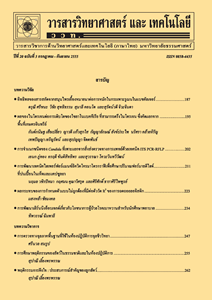การประยุกต์ข้อมูลจากระบบเรดาร์คลื่นวิทยุความถี่สูง แบบจำลอง GNOME และระบบสารสนเทศภูมิศาสตร์สำหรับคาดการณ์การเคลื่อนที่ของคราบน้ำมันในทะเล
Main Article Content
Abstract
บทคัดย่อ
การประยุกต์ข้อมูลจากระบบเรดาร์คลื่นวิทยุความถี่สูง แบบจำลอง GNOME และระบบสารสนเทศภูมิศาสตร์ สำหรับคาดการณ์การเคลื่อนที่ของคราบน้ำมันในทะเล มีวัตถุประสงค์เพื่อคาดการณ์การเคลื่อนที่ของคราบน้ำมันในทะเล บริเวณพื้นที่อ่าวไทยตอนบนฝั่งตะวันออก ครอบคลุมช่วงฤดูมรสุมตะวันออกเฉียงเหนือ ฤดูมรสุมตะวันตกเฉียงใต้ และช่วงเปลี่ยนฤดูมรสุมของทั้งสองฤดู โดยนำเข้าข้อมูลความเร็วและทิศทางกระแสน้ำที่ผิวหน้าน้ำทะเลรายชั่วโมงจากระบบเรดาร์คลื่นวิทยุความถี่สูง ซึ่งผ่านขั้นตอนการจัดเตรียมข้อมูล และประมาณค่าในช่วงให้ครอบคลุมพื้นที่ศึกษา ข้อมูลความเร็วและทิศทางลมจากสถานีตรวจอากาศอัตโนมัติ สถานีเกาะสีชัง ข้อมูลขอบเขตชายฝั่งและขอบเขตเกาะจากการแปลตีความจากข้อมูลภาพถ่ายจากดาวเทียม LANDSAT-8 พร้อมทั้งกำหนดค่าการแพร่กระจายในแนวราบและค่าอิทธิพลของลม ตามผลการศึกษาและปรับเทียบแบบจำลองของกรมควบคุมมลพิษ โดยพิจารณาเลือกช่วงเวลาในช่วงน้ำเกิดและน้ำตายในแต่ละฤดูมรสุม และกำหนดตำแหน่งทดสอบจากบริเวณที่มีการจราจรทางน้ำหนาแน่น บริเวณด้านหน้าท่าเรือแหลมฉบัง จังหวัดชลบุรี (ละติจูด 13.0715 องศาเหนือ ลองจิจูด 100.827 องศาตะวันออก) ผลการศึกษาพบว่าการเคลื่อนที่ของคราบน้ำมันในฤดูมรสุมตะวันออกเฉียงเหนือ มีทิศทางการเคลื่อนที่ไปทางทิศตะวันตกเฉียงใต้ของตำแหน่งทดสอบ ส่วนในฤดูมรสุมตะวันตกเฉียงใต้ มีทิศทางการเคลื่อนที่ไปทางตะวันออกเฉียงเหนือ เข้าหาชายฝั่ง ทั้งช่วงน้ำเกิดและน้ำตาย และในช่วงเปลี่ยนฤดูมรสุมทั้งสองฤดู มีทิศทางการเคลื่อนที่ไม่แน่นอน ขึ้นอยู่กับอิทธิพลของลมมรสุมในช่วงเวลานั้น ๆ ทั้งนี้ตัวแปรที่มีอิทธิพลสำคัญต่อรูปแบบการเคลื่อนที่ของคราบน้ำมัน คือ กระแสลม และรูปแบบการไหลเวียนของกระแสน้ำที่ผิวหน้าน้ำทะเล ผลจากการศึกษาในครั้งนี้สามารถนำไปใช้ในการสนับสนุนการดำเนินการภายใต้แผนการจัดการ แผนเผชิญเหตุ กรณีการรั่วไหลของน้ำมันในทะเล รวมไปถึงการปฏิบัติการภายใต้สถานการณ์จริง ตลอดจนสามารถนำกระบวนการประมวลผลข้อมูลและแบบจำลองใช้เป็นแนวทางและเครื่องมือในการนำข้อมูลเรดาร์คลื่นวิทยุความถี่สูงไปใช้ประโยชน์ในด้านการจัดการมลพิษทางทะเลต่อไปในอนาคต
คำสำคัญ : เรดาร์คลื่นวิทยุความถี่สูง; แบบจำลอง GNOME; ระบบสารสนเทศภูมิศาสตร์; คราบน้ำมัน
Abstract
Application of high-frequency radar systems, GNOME model and geographical information system (GIS) for predicting the movement of the oil slick in the sea in this paper aims to predict the movement of the oil slick in the sea areas on the eastward in the Gulf of Thailand, covering the northeast monsoon, the southwest monsoon and transition period of both seasons. By input the speed and direction of hourly sea surface current data from High Frequency radar systems. The process of preparing the data and interpolates values provided in the study area including wind speed and direction data from automated weather stations at Ko Sichang, coastal and island regions boundary, and the interpretation of satellite data from LANDSAT-8. Moreover, configuring diffusion horizontally and the influence of the wind according to the study result and calibration models of the Pollution Control Department by considering the timing of the spring tide and neap tide in each monsoon season. The tested position was done in a heavy traffic area in front of Laem Chabang port, Chon Buri province at latitude 13.0715 N and longitude 100.827 E. The results showed that the movement of the oil slick in the northeast monsoon had direction to the southwest of the tested location. In the southwest monsoon, the oil slick directed to the northeast toward to the Chon Buri and Sichang’s coast both spring and neap tide period and in the transition period of two monsoons found the unpredictable movement which based on the influence of the monsoon during the time period. The study concluded that the variables that have a major influence on the pattern of the oil slick movement were the wind and circulation patterns of surface currents. Also the results of this study can be used to support the implementation of the management plan, incident cases of oil spills at the sea, as well as operating under a real situation including utilized this data processing and the model to be as a guideline and tool for taking advantage from high-frequency radar systems in the management of marine pollution in the future.
Keywords: high frequency radar; GNOME; geographic information system; oil spill


